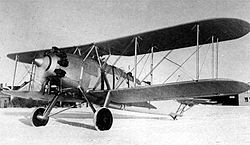Heinkel He 50
| Heinkel He 50 | |
|---|---|
 He 66, the export version of the He 50 |
|
| Type: | Dive fighter |
| Design country: | |
| Manufacturer: | |
| First flight: |
1931 |
| Commissioning: |
1935 |
| Number of pieces: |
93 |
The Heinkel He 50 ( HD 50 ) was a single-engine marine reconnaissance and dive fighter aircraft produced by Ernst Heinkel Flugzeugwerke .
technical description
The He 50 was a two-seat biplane with braced wings. The wings were partially covered with light metal, otherwise covered with fabric. The hull was made of welded steel tubes; the front part up to the two seats was covered with light metal, the remaining part covered with fabric. It could be equipped with double floats or a landing gear with a fixed spur.
history
The first prototypes produced on behalf of the Navy were still equipped with Junkers L-5 engines, but these turned out to be too weak. The He 50 was then equipped with an air-cooled Siemens “Jupiter” engine. Series production took place in 1935 at Heinkel (a total of 60 He 50s), then in 1936 at Bayerische Flugzeugwerke (15 aircraft) and Focke-Wulf (18 aircraft).
Series production began even during testing. A copy called the He 66 was delivered to Japan in December 1933 and, after installing a local engine, was built in series as the Aichi D1A . At least 24 pieces of the export version He 66 were made for China in 1934 and 1935. As part of the testing, an He 50 was used in the Condor Legion .
The machines were used as diving school machines and for experiments as possible carrier aircraft for the Graf Zeppelin . In the first half of 1939, extensive brake landing attempts for the carrier operation took place in Travemünde. A deployment did not take place, the extensive tests remained. The 37 He 50 T1s , which had been modified for carrier flight operations, were parked in the Pillau sea air base and were intended for scrapping. Instead, these were assigned to the "Buschmann Staffel" by NSGr 11 on April 2, 1943 as initial equipment. The mission took place in the northern section of the Eastern Front, the He 50 were flown by Estonian volunteers.
Technical specifications
| Parameter | He 50a (prototype float version) |
He 50a (V-1, prototype wheel version) |
He 50 A-2 |
|---|---|---|---|
| Construction year | 1931 | 1932 | 1933 |
| crew | 2 | ||
| length | 10.02 m | 9.60 m | |
| span | 11.50 m | ||
| height | 4.5 m | 4.13 m | 4.06 m |
| Wing area | 34.80 m² | ||
| Preparation mass | 1760 kg | 1535 kg | 1600 kg |
| Takeoff mass | 2210 kg | 2335 kg | 2620 kg |
| Top speed | 185 km / h near the ground | 246 km / h at an altitude of 1000 m | 230 km / h near the ground |
| Marching speed | 170 km / h | 220 km / h | 190 km / h at an altitude of 800 m |
| Landing speed | 82 km / h | 95 km / h | |
| Rise time | 3.0 min at 1000 m altitude 6.5 min at 2000 m altitude 16.0 min at 4000 m altitude |
||
| Service ceiling | 5400 m | 6400 m | |
| Range | 650 km | ||
| Engine | 1 × Junkers L 5 G | 1 × Siemens "Jupiter VI 5.3" | 1 × Siemens & Halske SAM 322B |
| Starting power | 380 hp (279 kW) | 490 PS (360 kW) | 600 hp (441 kW) |
See also
literature
- Heinkel . Chronicle and data sheets from Heinkel-Flugzeugbau. 3. Edition. Aviatic, Oberhaching 1996, ISBN 3-925505-08-3 .
- Volker Koos: Ernst Heinkel Flugzeugwerke 1922–1932 . Heel, Königswinter 2006, ISBN 3-89880-502-6 .
- Volker Koos: Ernst Heinkel Flugzeugwerke 1933–1945 . Heel, Königswinter 2003, ISBN 3-89880-217-5 .
- Helmut Stützer: The German military aircraft 1919–1934 . E. S. Mittler & Sohn, Herford 1984, ISBN 3-8132-0184-8 .
Web links
Individual evidence
- ↑ a b Manfred Griehl: Typenkompass Heinkel. Motorbuch Verlag Stuttgart 2012, ISBN 978-3-613-03424-2
- ^ A b Volker Koos: Ernst Heinkel Flugzeugwerke 1933–1945. Heel Verlag, Königswinter 2003, pp. 20–22
